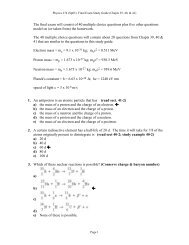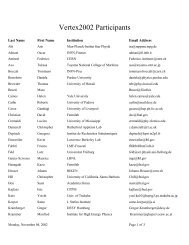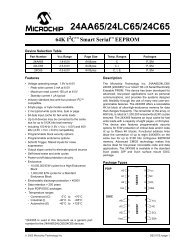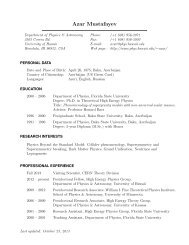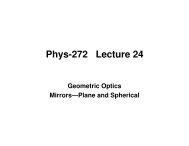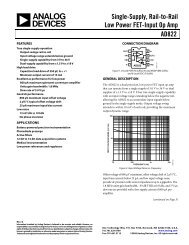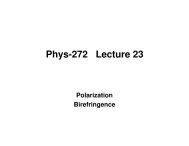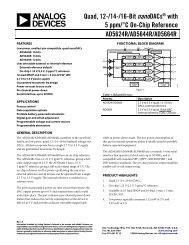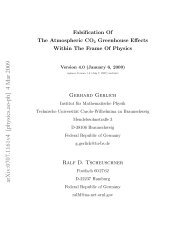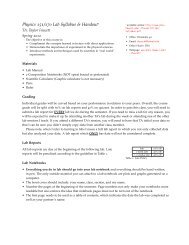Impact of Residual Stress in HPFS Fused Silica
Impact of Residual Stress in HPFS Fused Silica
Impact of Residual Stress in HPFS Fused Silica
Create successful ePaper yourself
Turn your PDF publications into a flip-book with our unique Google optimized e-Paper software.
The analogous expressions <strong>in</strong> terms <strong>of</strong> stress <strong>in</strong>stead <strong>of</strong> stra<strong>in</strong> are<br />
(∆n) x = (-n 3 0 /2) (q 11 σ x + q 12 σ y + q 12 σ z )<br />
(∆n) y = (-n 3 0 /2) (q 12 σ x + q 11 σ y + q 12 σ z )<br />
(∆n) z = (-n 3 0 /2) (q 12 σ x + q 12 σ y + q 11 σ z )<br />
(4a)<br />
(4b)<br />
(4c)<br />
where the σ’s are now stresses along the pr<strong>in</strong>ciple axes.<br />
<strong>Stress</strong> and stra<strong>in</strong> are related through the elastic properties <strong>of</strong> the material. For an isotropic material, only the Young’s<br />
modulus E and the Poisson ratio ν are needed, and the relations are<br />
e x = (1/E) (σ x – ν (σ y +σ z ))<br />
e y = (1/E) (σ y – ν (σ z +σ x ))<br />
e z = (1/E) (σ z – ν (σ x +σ y )) (5)<br />
The two descriptions <strong>of</strong> <strong>in</strong>dex change <strong>in</strong> Eqs. (3) and (4) must agree and be consistent with Eqs.(5), so we can deduce the<br />
relations between stra<strong>in</strong>-optic and stress-optic coefficients<br />
q 11 = (1/E) (p 11 – 2 ν p 12 )<br />
q 12 = (1/E) (p 12 – ν (p 11 +p 12 )) (6)<br />
If light is travel<strong>in</strong>g down the z axis, then the birefr<strong>in</strong>gence <strong>of</strong> the sample is the difference between (∆n) x and (∆n) y , i.e.<br />
BR = (∆n) x - (∆n) y = (-n 0 3 /2) (q 11 -q 12 ) (σ x -σ y ) (7)<br />
where σ x and σ y are now averaged along the light path through the sample.<br />
Several other relations can be derived from the equations above. For example, <strong>in</strong> most cases the stra<strong>in</strong> can be approximated<br />
as be<strong>in</strong>g isotropic <strong>in</strong> each small region <strong>of</strong> the sample (e.g. with<strong>in</strong> each element <strong>of</strong> a f<strong>in</strong>ite element calculation). This leads to<br />
the isotropic approximation for <strong>in</strong>dex variation<br />
(∆n) iso = (-n 0 3 /2) ((p 11 +2p 12 )/3) (e x +e y +e z ) (8)<br />
The sum <strong>of</strong> the three stra<strong>in</strong>s (e x +e y +e z ) is a fractional volume change, or the negative <strong>of</strong> a fractional density change. Thus<br />
Eq.(8) shows a l<strong>in</strong>ear proportionality between a density <strong>in</strong>crease and an isotropic <strong>in</strong>crease <strong>in</strong> <strong>in</strong>dex <strong>of</strong> refraction.<br />
Consider<strong>in</strong>g light propagat<strong>in</strong>g down the z axis, we have<br />
(∆n) avg = (∆n x + ∆n y )/2 = (-n 0 3 /2) ((q 11 +q 12 )(σ x +σ y )/2 + q 12 σ z ) (9)<br />
This expression should represent the refractive <strong>in</strong>dex contribution to wavefront distortion measured by circularly polarized<br />
light used <strong>in</strong> <strong>in</strong>terferometry. The measurement would actually detect (∆n) avg <strong>in</strong>tegrated through the sample thickness, so the<br />
result depends on all three pr<strong>in</strong>ciple stresses <strong>in</strong>tegrated through the sample thickness.<br />
Page 5 <strong>of</strong> 8




